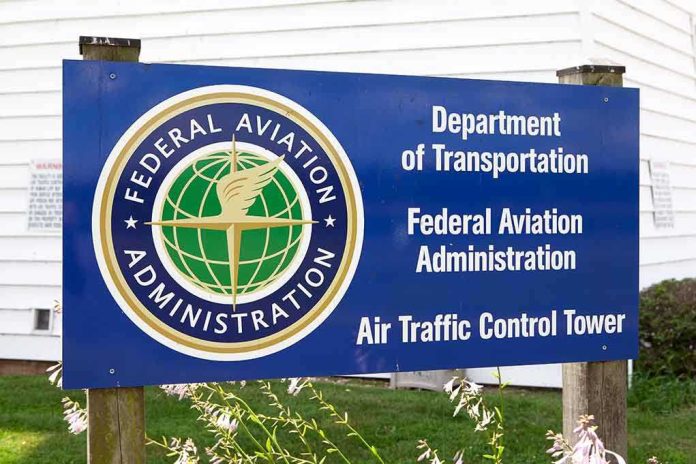
A single government shutdown has unleashed the largest wave of flight cancellations and delays in U.S. history, exposing the fragility of our air travel system and the high-stakes reality behind every ticket booked this holiday season.
Story Snapshot
- Over 1,500 flights canceled and 6,500 delayed nationwide following an unprecedented FAA emergency order
- Flight cuts mandated by the FAA are a direct response to chronic air traffic controller shortages and the longest government shutdown ever
- Major airlines scramble to comply, slashing schedules up to 10% at forty key airports during peak travel season
- Travelers, airline staff, and businesses face mounting chaos with no political solution in sight
Government Shutdown Forces FAA’s Hand, Disrupts Air Travel
Congress’s failure to pass appropriations bills triggered a government shutdown on October 1, 2025, locking the gears of federal funding and sending shockwaves through agencies dependent on those resources. The FAA, charged with safeguarding the nation’s airspace, found itself critically understaffed as air traffic controllers faced mounting pressure without pay or support. With the shutdown dragging past the 40-day mark, the FAA issued a rare emergency order on November 7, mandating phased reductions in flight operations at the country’s busiest airports. The order’s goal: maintain safety and prevent catastrophic errors in an overstressed system.
As the mandate took effect, the repercussions rippled outward. Airlines began slashing their schedules, with American, Delta, and United confirming reductions of up to 6% at forty airports by November 11, amounting to hundreds of flights grounded or rescheduled. Travelers faced the brunt of the fallout: over 1,500 flights canceled and 6,500 delayed between November 8 and 10 alone. The crisis unfolded just as millions prepared for holiday journeys, turning airports into scenes of frustration and confusion.
Airlines and Airports Struggle Under FAA Mandate
Major airlines, bound by federal directives, scrambled to adjust their operations. American Airlines announced a 6% cut in schedules at affected airports for November 11, as required by the FAA’s emergency order. The phased reductions were set to escalate: 4% by November 7, 6% by November 11, 8% by November 13, and a staggering 10% by November 14. This systematic approach aimed to balance safety with operational feasibility, but the reality for carriers was grim. Each cancellation meant lost revenue, logistical headaches, and the ire of stranded customers. For air traffic controllers left on duty, the workload intensified amid staffing shortages, raising concerns about fatigue and morale.
Travelers scrambled for rebooking options, with airlines sending out notifications and offering limited solutions. Meanwhile, the airline industry braced for ongoing losses, as the shutdown showed no signs of resolution. The FAA’s intervention, though necessary for safety, exposed the delicate balance between federal funding, staffing, and the relentless demand for air travel in America.
Systemic Vulnerabilities Revealed by Crisis
This episode marks the first time a government shutdown has forced the FAA to mandate widespread flight reductions, highlighting systemic vulnerabilities in the National Airspace System. Chronic staffing shortages among air traffic controllers had strained the system for years, but the shutdown pushed it to the breaking point. Previous incidents, such as the 2019 shutdown, caused delays but never reached this scale. The current crisis not only disrupts travel but also erodes public confidence in the reliability and resilience of U.S. aviation infrastructure.
The ripple effects extend beyond passengers and airlines. Businesses relying on air cargo face delays, and communities dependent on air travel find themselves isolated. The economic impact touches airports, hospitality, and tourism sectors. Social frustration mounts, with public outcry over political gridlock and government dysfunction. The showdown in Congress becomes more than a legislative impasse—it’s a test of the nation’s ability to maintain essential services under stress.
Calls for Reform and Expert Analysis
Aviation analysts warn that prolonged operational reductions could have cascading effects, from diminished airline revenues to lasting changes in scheduling and contingency planning. Experts in transportation policy argue that this crisis exposes the fragility of critical infrastructure when political and funding mechanisms fail. Some call for bipartisan cooperation to prevent future shutdowns; others advocate for greater automation and modernization in air traffic control to reduce reliance on federal appropriations.
The FAA’s emergency order and airline statements provide clear, authoritative information about the operational changes underway. Major news outlets corroborate the scale and impact of the disruptions. No significant contradictions exist among sources: all confirm that the shutdown and staffing shortages are the root causes, and that the phased reductions will continue until a political solution is reached. The story serves as a stark reminder that the reliability of air travel—and the freedom to move across the country—can hinge on the tenuous workings of Washington.
Sources:
FAA Emergency Order (official government document)













